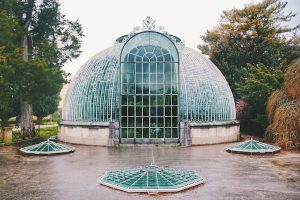
Struggling with limited gardening space? Lean-to greenhouses offer a smart solution.
This post will guide you through their benefits, installation, and how they can transform your garden oasis.
Definition of a Lean-To Greenhouse
A lean-to greenhouse is built against a solid surface or wall. This

setup makes it perfect for small spaces. It creates a controlled environment for plants, making sure they grow well.
The structure relies on the wall not just for support but also to use less material than freestanding greenhouses. With glazing options like horticultural glass or toughened glass, these greenhouses can keep your plants safe while letting in plenty of light.
Lean-to greenhouses fit well in gardens and next to garages or conservatories, using the existing walls to their advantage. They offer an effective way to garden in limited spaces, helping gardeners grow fruits and vegetables throughout the year. Since they are attached to a building, they’re easier and often cheaper to heat during colder months compared to their standalone counterparts.
Key Features of Lean-To Greenhouses
Lean-to greenhouses stand against a wall, saving space. They make temperature control easier, leading to greater stability for plants. These greenhouses are versatile and fit different garden needs.
You can move outdoor plants inside easily. Lean-tos add beauty and value to properties too.
They need less upkeep than other types of conservatories. Windows help in managing the warmth and light that get in. This setup is great for growing flowers from cuttings or keeping flowerpots thriving in cooler months.
Benefits of Lean-To Greenhouses
Lean-to greenhouses impress with better plant growth, quality, and speed. They use walls for support and capture more sunlight. This setup ensures plants thrive. Your property looks better and may even gain value.
These greenhouses stand strong in bad weather too, protecting your garden efforts all year round.
Installation Process
Setting up a lean-to greenhouse takes careful planning. You need the right tools, space, and steps to make sure it stands strong.
- Choose a wall that gets plenty of sunlight. This spot should face the sun for most of the day.
- Clear the area. Make sure the ground is flat and remove any plants or rocks.
- Prepare the base. It should be level and can be made of concrete for extra strength.
- Attach the greenhouse frame to your chosen wall. Use strong fixings so it won’t come loose.
- Add roof panels next, ensuring they’re secure and tight to prevent leaks.
- Put in side panels to complete the structure’s walls.
- Fix door panels last, making sure they open easily and seal when closed.
- Install stabilisation kits around the greenhouse for wind protection.
- Seal all joints with weatherproof sealant to keep out dampness and cold air.
- Check everything is tight, secure, and stable before use.
With these steps, gardeners can enjoy their new space ready for planting and growing all year round!
Space and Location Considerations
Choosing the right spot for a lean-to greenhouse is critical. It needs a sturdy wall or surface to stand against. This ensures stability and support for your structure. Also, consider sunlight when picking a location. Your plants need lots of light to grow well.
Make sure the spot gets plenty of sun throughout the day. Space around your greenhouse matters too. You’ll want enough room not just for plant growth inside but also for easy maintenance work outside. Think about how you’ll move around the greenhouse to water and care for your plants. Allow extra space so you can easily access all parts of the greenhouse without hassle.
Temperature Control and Stability
Lean-to greenhouses make it easier to keep plants warm or cool. Heaters and fans help with this. They also stay more stable in bad weather. You can use things like bubble wrap for extra warmth.
Keeping the right temperature is key for plant growth. This kind of greenhouse does that well, using less energy. It helps gardeners save money on bills too.
Plant Protection and Growth Enhancement

In lean-to greenhouses, plants get strong protection from pests and bad weather. Grow lights and shade cloths create the best conditions for them to grow. This means plants are healthier and grow faster.
Garden owners see their plants bloom more with these setups. This setup keeps your garden safe from harm and helps every plant reach its full potential quickly.
Using such tools also improves the quality of your harvest. You get more flowers or vegetables because the environment is just right for growth. It’s like shielding your garden against problems while boosting what it can produce.
Aesthetic and Property Value Benefits

Lean-to greenhouses add a charming look to gardens, making them more appealing. Matching the design with your house style makes everything look put together. This addition can also make your property more valuable.
People love homes with attractive and useful features like this kind of greenhouse. It’s clear – adding one to your space might mean higher interest if you sell one day.
Conversion of Freestanding Greenhouses to Lean-To Greenhouses
Turning a freestanding greenhouse into a lean-to structure gives your garden a boost. It makes the most of existing walls and saves space. Here are the steps to make it happen:
- Choose a suitable wall for the conversion. The wall should face the sun to get enough light.
- Prepare the base by making it level and strong. This will support your greenhouse well.
- Remove one side of the panels from your freestanding greenhouse. These panels won’t be needed anymore.
- Push the greenhouse against the chosen wall, making sure it’s straight and secure.
- Reinforce the structure by attaching it firmly to the wall. Use bolts and brackets for extra strength.
- Add stabilisation kits. These kits help your greenhouse stand firm against wind and weather.
- Seal gaps between the greenhouse and wall properly, preventing air leaks.
- Insulate the adjoining surfaces to keep heat in during cooler months.
Follow these steps for a smooth conversion from a freestanding to a lean-to greenhouse, enhancing your garden’s function and appearance while saving space efficiently.
Supplementary Insights on Lean-To Greenhouses
For those who dive deeper, lean-to greenhouses hold more secrets. Think about adding fans or heaters, and getting your hands dirty with seasonal upkeep to boost your plants’ lives.
Common Accessories for Lean-To Greenhouses
Lean-to greenhouses need the right gear to make them work better. Here are some top tools and add-ons garden owners use a lot:
- Kits for adding parts or fixing things come in handy.
- Heaters keep plants warm when it gets cold outside.
- Grow lights help plants grow strong, even with less sunlight.
- Shade cloths protect plants from too much sun.
- Composters turn waste into food for plants.
- Solar power systems save on electricity bills.
- Shelves give more space for plants.
- Flooring stops weeds and keeps pests away.
- Watering systems make sure all plants get enough water.
- Tie-down kits keep the greenhouse safe in wind or storms.
These items help lean-to greenhouses work well all year round, making gardening easier and more fun.
How to Buy a Lean-To Greenhouse
Buying a lean-to greenhouse is a smart choice for gardeners. It adds space for plants and can be a lovely part of your home. The following advice is provided by Halls Greenhouses.
- Set your budget. Know how much you want to spend on the greenhouse, including extra costs.
- Measure your space. Decide where the greenhouse will go and how big it can be.
- Choose the right material. Glass or polycarbonate panels are popular choices.
- Look for low maintenance options. Some materials need less care over time.
- Consider temperature control features. Ventilation and shading help keep plants happy.
- Check for pressure-treated frames to resist rot.
- Think about aesthetics. Pick a style that matches your home or garden look.
- Explore types of greenhouses available, like elite options which offer extra features.
- Learn about installation processes to see if you need professional help or can do it yourself.
- Find out what accessories you might need – like misting systems – to boost plant growth.
- Read product reviews and comparisons to choose the best one for your needs.
- Contact sellers directly for more information or advice.
This simple guide helps make buying a lean-to greenhouse clear and straightforward, so you can start enjoying its benefits soon!
![]()
Author Profile
- Passionate content creator, contributor, freelance writer and content marketing allrounder.
Latest entries
 Green LivingApril 17, 20254 Eco-Friendly Habits to Pair With Your Herbal Tea Ritual
Green LivingApril 17, 20254 Eco-Friendly Habits to Pair With Your Herbal Tea Ritual Best practicesApril 12, 2025Top 6 Eco-Friendly Choices for Sustainable Living in Your Everyday Life
Best practicesApril 12, 2025Top 6 Eco-Friendly Choices for Sustainable Living in Your Everyday Life BusinessMarch 31, 2025How to furnish your Office with sustainable Cardboard Furniture
BusinessMarch 31, 2025How to furnish your Office with sustainable Cardboard Furniture Best practicesMarch 21, 202511 Practical Ways to Limit Your Exposure to Microplastic Pollution
Best practicesMarch 21, 202511 Practical Ways to Limit Your Exposure to Microplastic Pollution






Leave a Reply
You must be logged in to post a comment.